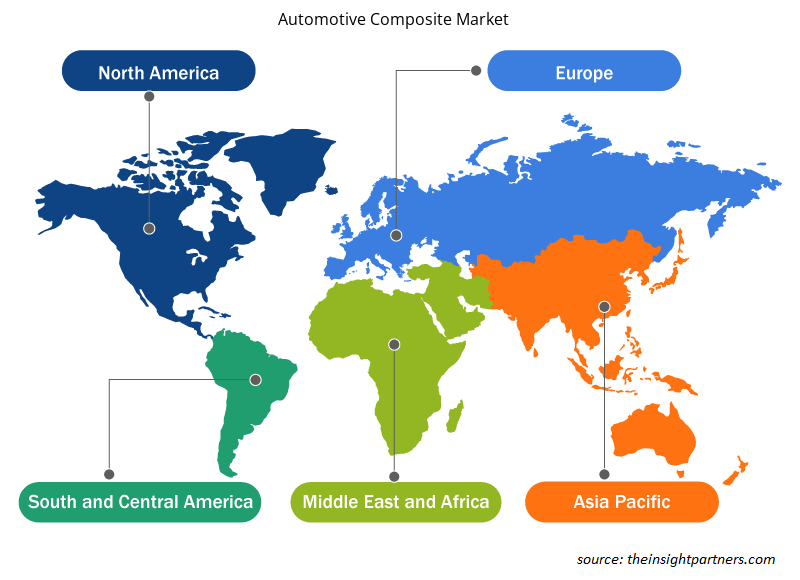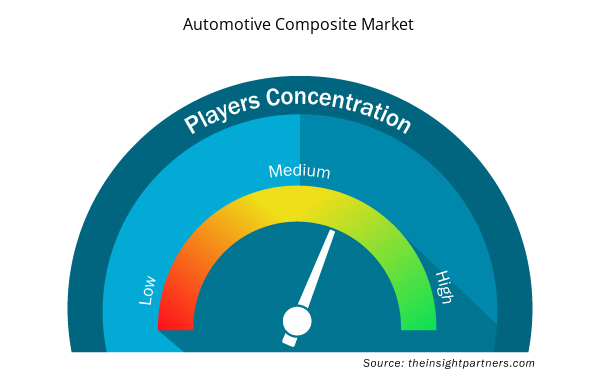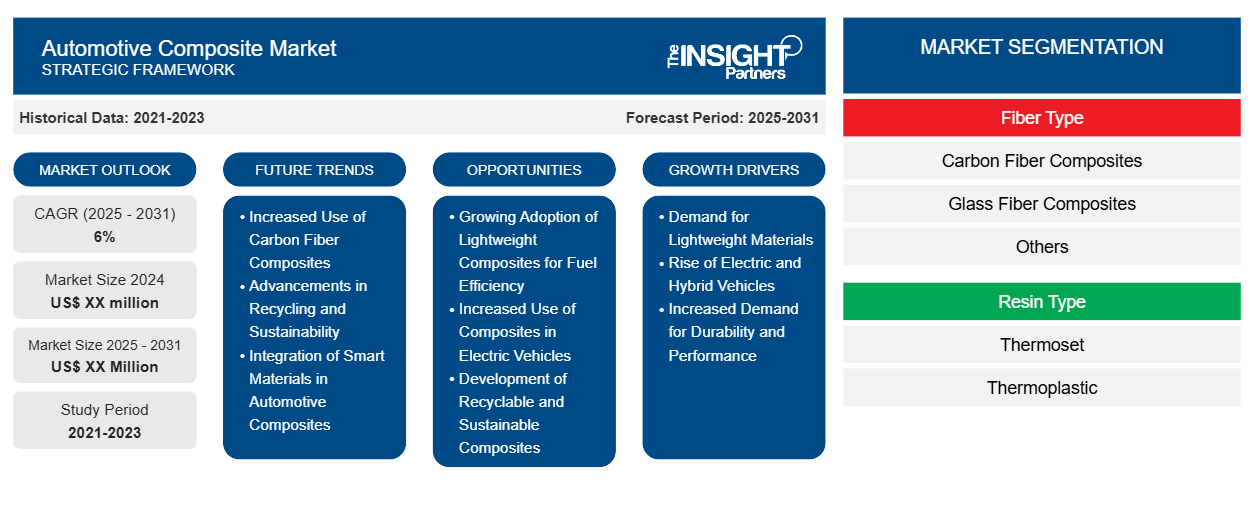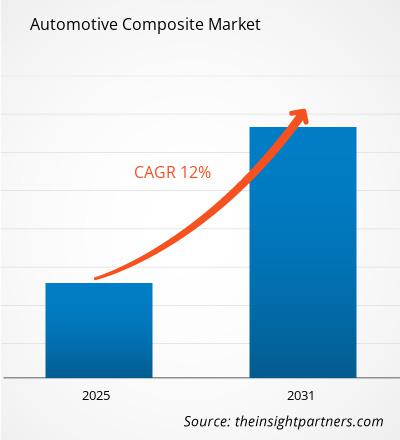Es wird erwartet, dass der Markt für Automobilverbundwerkstoffe von 2023 bis 2031 eine durchschnittliche jährliche Wachstumsrate (CAGR) von 6 % verzeichnet und dass die Marktgröße von XX Millionen US-Dollar im Jahr 2023 auf XX Millionen US-Dollar im Jahr 2031 wächst.
Der Bericht ist nach Fasertyp (Kohlefaserverbundwerkstoffe, Glasfaserverbundwerkstoffe und andere) segmentiert. Der Bericht präsentiert außerdem Analysen basierend auf Harztyp [Duroplast (Polyester, Vinylester, Epoxid, Polyurethan und andere), Thermoplast (Polypropylen, Polyethylen, Polyvinylchlorid, Polystyrol, Polyethylenterephthalat, Polycarbonat und andere)]. Basierend auf dem Fahrzeugtyp ist der Bericht segmentiert in (Personenkraftwagen, leichte Nutzfahrzeuge (LCV), schwere Nutzfahrzeuge und Zweiräder und andere). Die globale Analyse ist weiter auf regionaler Ebene und in den wichtigsten Ländern aufgeschlüsselt. Der Bericht bietet den Wert in USD für die oben genannte Analyse und Segmente.
Zweck des Berichts
Der Bericht Automotive Composite Market von The Insight Partners zielt darauf ab, die aktuelle Landschaft und das zukünftige Wachstum sowie die wichtigsten treibenden Faktoren, Herausforderungen und Chancen zu beschreiben. Dies wird verschiedenen Geschäftspartnern Einblicke geben, wie zum Beispiel:
- Technologieanbieter/-hersteller: Um die sich entwickelnde Marktdynamik zu verstehen und die potenziellen Wachstumschancen zu kennen, damit sie fundierte strategische Entscheidungen treffen können.
- Investoren: Durchführung einer umfassenden Trendanalyse hinsichtlich der Marktwachstumsrate, der finanziellen Marktprognosen und der Chancen entlang der Wertschöpfungskette.
- Regulierungsbehörden: Zur Regulierung von Richtlinien und Überwachungsaktivitäten auf dem Markt mit dem Ziel, Missbrauch zu minimieren, das Vertrauen der Anleger zu bewahren und die Integrität und Stabilität des Marktes aufrechtzuerhalten.
Marktsegmentierung für Automobilverbundwerkstoffe
Fasertyp
- Kohlenstofffaserverbundwerkstoffe
- Glasfaserverbundwerkstoffe
- Sonstiges
Harztyp
- Duroplast
- Thermoplast
Passen Sie diesen Bericht Ihren Anforderungen an
Sie erhalten kostenlose Anpassungen an jedem Bericht, einschließlich Teilen dieses Berichts oder einer Analyse auf Länderebene, eines Excel-Datenpakets sowie tolle Angebote und Rabatte für Start-ups und Universitäten.
- Holen Sie sich die wichtigsten Markttrends aus diesem Bericht.Dieses KOSTENLOSE Beispiel umfasst eine Datenanalyse von Markttrends bis hin zu Schätzungen und Prognosen.
Wachstumstreiber auf dem Automobil-Verbundstoffmarkt
- Nachfrage nach Leichtbaumaterialien: Die Automobilindustrie konzentriert sich zunehmend auf die Reduzierung des Fahrzeuggewichts, um den Kraftstoffverbrauch zu verbessern und die Emissionen zu senken. Automobilverbundstoffe wie kohlenstofffaserverstärkte Kunststoffe und Glasfaserverbundstoffe bieten Leichtbaulösungen ohne Kompromisse bei Festigkeit und Haltbarkeit. Ihr Einsatz in Karosserieteilen, Fahrgestellen und Innenräumen nimmt zu.
- Aufstieg von Elektro- und Hybridfahrzeugen: Die wachsende Beliebtheit von Elektrofahrzeugen (EVs) und Hybridfahrzeugen, die leichte Materialien erfordern, um die Batterieleistung und Reichweite zu maximieren, treibt die Nachfrage nach Automobilverbundwerkstoffen an. Diese Materialien tragen zur Verbesserung der Gesamtenergieeffizienz bei und bieten ein verbessertes Verhältnis von Festigkeit zu Gewicht.
- Erhöhte Anforderungen an Haltbarkeit und Leistung: Automobilverbundstoffe sind für ihre Haltbarkeit, Korrosionsbeständigkeit und Widerstandsfähigkeit gegenüber rauen Umweltbedingungen bekannt. Da Fahrzeuge technologisch immer fortschrittlicher werden, steigt der Bedarf an Materialien, die eine hohe Leistung bieten und gleichzeitig leicht, korrosionsbeständig und kostengünstig sind, weiter an.
Zukünftige Trends auf dem Automobil-Verbundstoffmarkt
- Verstärkter Einsatz von Kohlefaserverbundwerkstoffen: Da die Automobilhersteller sich auf die Verbesserung der Kraftstoffeffizienz und die Reduzierung des Fahrzeuggewichts konzentrieren, ist zu erwarten, dass Kohlefaserverbundwerkstoffe immer weiter verbreitet sein werden. Diese Materialien bieten ein hervorragendes Verhältnis von Festigkeit zu Gewicht und verbessern so die Fahrzeugleistung und Energieeffizienz, insbesondere bei Elektrofahrzeugen, Luxusautos und Hochleistungssportwagen.
- Fortschritte bei Recycling und Nachhaltigkeit: In Zukunft wird der Schwerpunkt bei Automobilverbundwerkstoffen auf der Verbesserung der Recyclingfähigkeit von Verbundwerkstoffen liegen. Die Entwicklung von Verbundwerkstoffen, die leichter zu recyceln und nachhaltiger sind, wird das Wachstum im Automobilsektor vorantreiben, da Umweltbelange und Abfallreduzierung immer wichtiger werden.
- Integration intelligenter Materialien in Automobilverbundwerkstoffe: Die Verbreitung intelligenter Verbundwerkstoffe mit selbstheilenden Eigenschaften, Sensoren und anderen integrierten Funktionen dürfte die Automobilindustrie revolutionieren. Mithilfe dieser Materialien können Fahrzeuge ihren Zustand überwachen, kleinere Schäden reparieren und die Gesamtleistung des Fahrzeugs verbessern, was zu einer längeren Lebensdauer und geringeren Wartungskosten führt.
Marktchancen für Verbundwerkstoffe im Automobilbereich
- Zunehmende Nutzung von Leichtbau-Verbundwerkstoffen zur Kraftstoffeffizienz: Da Automobilhersteller sich auf die Verbesserung der Kraftstoffeffizienz konzentrieren, stellen Leichtbau-Verbundwerkstoffe wie Kohlefaser und Glasfaser eine wichtige Marktchance dar. Diese Materialien werden in Karosserieteile, Fahrgestelle und Innenraumkomponenten von Fahrzeugen integriert, um das Gewicht zu reduzieren, die Leistung zu verbessern und gesetzliche Emissionsziele zu erreichen.
- Verstärkter Einsatz von Verbundwerkstoffen in Elektrofahrzeugen: Die Umstellung auf Elektrofahrzeuge bietet erhebliche Chancen für den Markt für Automobilverbundwerkstoffe. Elektrofahrzeuge erfordern leichte Materialien, um die Reichweite und Effizienz der Batterie zu maximieren, und Verbundwerkstoffe sind für diesen Zweck ideal. Mit der zunehmenden Produktion von Elektrofahrzeugen wird die Nachfrage nach fortschrittlichen Verbundwerkstoffen in Bereichen wie Batteriegehäusen, Strukturkomponenten und Innenraumelementen steigen.
- Entwicklung von recycelbaren und nachhaltigen Verbundwerkstoffen: Mit zunehmender Betonung der Nachhaltigkeit gibt es einen wachsenden Markt für recycelbare und umweltfreundliche Verbundwerkstoffe für die Automobilindustrie. Hersteller entwickeln innovative Verbundwerkstoffe auf Biobasis und recycelbare Materialien, die sowohl Leistungs- als auch Umweltanforderungen erfüllen und damit eine lukrative Chance im Bereich der grünen Automobilindustrie darstellen.
Regionale Einblicke in den Automobil-Verbundstoffmarkt
Die regionalen Trends und Faktoren, die den Markt für Automobilverbundwerkstoffe im Prognosezeitraum beeinflussen, wurden von den Analysten von Insight Partners ausführlich erläutert. In diesem Abschnitt werden auch die Marktsegmente und die Geografie des Automobilverbundwerkstoffs in Nordamerika, Europa, im asiatisch-pazifischen Raum, im Nahen Osten und Afrika sowie in Süd- und Mittelamerika erörtert.

- Erhalten Sie regionale Daten zum Automobil-Verbundstoffmarkt
Umfang des Marktberichts zu Verbundwerkstoffen für Kraftfahrzeuge
| Berichtsattribut | Details |
|---|---|
| Marktgröße im Jahr 2023 | XX Millionen US-Dollar |
| Marktgröße bis 2031 | XX Millionen US-Dollar |
| Globale CAGR (2023 - 2031) | 6 % |
| Historische Daten | 2021-2022 |
| Prognosezeitraum | 2024–2031 |
| Abgedeckte Segmente | Nach Fasertyp
|
| Abgedeckte Regionen und Länder | Nordamerika
|
| Marktführer und wichtige Unternehmensprofile |
|
Dichte der Marktteilnehmer für Automobilverbundwerkstoffe: Auswirkungen auf die Geschäftsdynamik verstehen
Der Markt für Verbundwerkstoffe für die Automobilindustrie wächst rasant. Dies wird durch die steigende Nachfrage der Endverbraucher aufgrund von Faktoren wie sich entwickelnden Verbraucherpräferenzen, technologischen Fortschritten und einem größeren Bewusstsein für die Vorteile des Produkts vorangetrieben. Mit der steigenden Nachfrage erweitern Unternehmen ihr Angebot, entwickeln Innovationen, um die Bedürfnisse der Verbraucher zu erfüllen, und nutzen neue Trends, was das Marktwachstum weiter ankurbelt.
Die Marktteilnehmerdichte bezieht sich auf die Verteilung von Firmen oder Unternehmen, die in einem bestimmten Markt oder einer bestimmten Branche tätig sind. Sie gibt an, wie viele Wettbewerber (Marktteilnehmer) in einem bestimmten Marktraum im Verhältnis zu seiner Größe oder seinem gesamten Marktwert präsent sind.
Die wichtigsten auf dem Markt für Automobilverbundwerkstoffe tätigen Unternehmen sind:
- Toray Industries Inc.
- SGL Carbon
- TEJIN LIMITED
- Mitsubishi Chemical Corporation.
- Hexcel Corporation
Haftungsausschluss : Die oben aufgeführten Unternehmen sind nicht in einer bestimmten Reihenfolge aufgeführt.

- Überblick über die wichtigsten Akteure auf dem Automobil-Verbundwerkstoffmarkt
Wichtige Verkaufsargumente
- Umfassende Abdeckung: Der Bericht deckt die Analyse von Produkten, Dienstleistungen, Typen und Endbenutzern des Automobil-Verbundwerkstoffmarktes umfassend ab und bietet einen ganzheitlichen Überblick.
- Expertenanalyse: Der Bericht basiert auf dem umfassenden Verständnis von Branchenexperten und Analysten.
- Aktuelle Informationen: Der Bericht stellt durch die Abdeckung aktueller Informationen und Datentrends Geschäftsrelevanz sicher.
- Anpassungsoptionen: Dieser Bericht kann angepasst werden, um spezifische Kundenanforderungen zu erfüllen und die Geschäftsstrategien optimal anzupassen.
Der Forschungsbericht zum Automotive Composite Market kann daher dabei helfen, die Branchensituation und Wachstumsaussichten zu entschlüsseln und zu verstehen. Obwohl es einige berechtigte Bedenken geben kann, überwiegen die allgemeinen Vorteile dieses Berichts tendenziell die Nachteile.
- Historische Analyse (2 Jahre), Basisjahr, Prognose (7 Jahre) mit CAGR
- PEST- und SWOT-Analyse
- Marktgröße Wert/Volumen – Global, Regional, Land
- Branche und Wettbewerbsumfeld
- Excel-Datensatz


- Medical Devices Market
- Fish Protein Hydrolysate Market
- Medical Enzyme Technology Market
- Data Annotation Tools Market
- Electronic Shelf Label Market
- Long Read Sequencing Market
- Photo Editing Software Market
- Medical Audiometer Devices Market
- Hot Melt Adhesives Market
- Single-Use Negative Pressure Wound Therapy Devices Market

Report Coverage
Revenue forecast, Company Analysis, Industry landscape, Growth factors, and Trends

Segment Covered
This text is related
to segments covered.

Regional Scope
North America, Europe, Asia Pacific, Middle East & Africa, South & Central America

Country Scope
This text is related
to country scope.
Häufig gestellte Fragen
DuPont de Nemours Inc, Gurit Holding AG, Hexion Inc, Mitsubishi Chemical Holdings Corp, Nippon Electric Glass Co Ltd, Owens Corning are some of the key players operating in the automotive composites market
Based on geography, Asia Pacific held the largest share of the automotive composites market due to the well-established automotive industry across the region
Increased use of carbon fiber composites is expected to be the key market trends.
Based on fiber type, the carbon fiber segment is expected to witness the fastest growth during the forecast period
The Automotive Composite Market is estimated to witness a CAGR of 12.0% from 2025 to 2031
Demand for lightweight materials is driving the automotive composites market growth.
Trends and growth analysis reports related to Chemicals and Materials : READ MORE..
The List of Companies
- Toray Industries Inc.
- SGL Carbon
- TEIJIN LIMITED
- Mitsubishi Chemical Corporation.
- Hexcel Corporation
- John Manville Corporation
- Owens Corning
- Zoltek Carbon Fiber
- Cytec Solvay Group
- Gurit
The Insight Partners performs research in 4 major stages: Data Collection & Secondary Research, Primary Research, Data Analysis and Data Triangulation & Final Review.
- Data Collection and Secondary Research:
As a market research and consulting firm operating from a decade, we have published and advised several client across the globe. First step for any study will start with an assessment of currently available data and insights from existing reports. Further, historical and current market information is collected from Investor Presentations, Annual Reports, SEC Filings, etc., and other information related to company’s performance and market positioning are gathered from Paid Databases (Factiva, Hoovers, and Reuters) and various other publications available in public domain.
Several associations trade associates, technical forums, institutes, societies and organization are accessed to gain technical as well as market related insights through their publications such as research papers, blogs and press releases related to the studies are referred to get cues about the market. Further, white papers, journals, magazines, and other news articles published in last 3 years are scrutinized and analyzed to understand the current market trends.
- Primary Research:
The primarily interview analysis comprise of data obtained from industry participants interview and answers to survey questions gathered by in-house primary team.
For primary research, interviews are conducted with industry experts/CEOs/Marketing Managers/VPs/Subject Matter Experts from both demand and supply side to get a 360-degree view of the market. The primary team conducts several interviews based on the complexity of the markets to understand the various market trends and dynamics which makes research more credible and precise.
A typical research interview fulfils the following functions:
- Provides first-hand information on the market size, market trends, growth trends, competitive landscape, and outlook
- Validates and strengthens in-house secondary research findings
- Develops the analysis team’s expertise and market understanding
Primary research involves email interactions and telephone interviews for each market, category, segment, and sub-segment across geographies. The participants who typically take part in such a process include, but are not limited to:
- Industry participants: VPs, business development managers, market intelligence managers and national sales managers
- Outside experts: Valuation experts, research analysts and key opinion leaders specializing in the electronics and semiconductor industry.
Below is the breakup of our primary respondents by company, designation, and region:

Once we receive the confirmation from primary research sources or primary respondents, we finalize the base year market estimation and forecast the data as per the macroeconomic and microeconomic factors assessed during data collection.
- Data Analysis:
Once data is validated through both secondary as well as primary respondents, we finalize the market estimations by hypothesis formulation and factor analysis at regional and country level.
- Macro-Economic Factor Analysis:
We analyse macroeconomic indicators such the gross domestic product (GDP), increase in the demand for goods and services across industries, technological advancement, regional economic growth, governmental policies, the influence of COVID-19, PEST analysis, and other aspects. This analysis aids in setting benchmarks for various nations/regions and approximating market splits. Additionally, the general trend of the aforementioned components aid in determining the market's development possibilities.
- Country Level Data:
Various factors that are especially aligned to the country are taken into account to determine the market size for a certain area and country, including the presence of vendors, such as headquarters and offices, the country's GDP, demand patterns, and industry growth. To comprehend the market dynamics for the nation, a number of growth variables, inhibitors, application areas, and current market trends are researched. The aforementioned elements aid in determining the country's overall market's growth potential.
- Company Profile:
The “Table of Contents” is formulated by listing and analyzing more than 25 - 30 companies operating in the market ecosystem across geographies. However, we profile only 10 companies as a standard practice in our syndicate reports. These 10 companies comprise leading, emerging, and regional players. Nonetheless, our analysis is not restricted to the 10 listed companies, we also analyze other companies present in the market to develop a holistic view and understand the prevailing trends. The “Company Profiles” section in the report covers key facts, business description, products & services, financial information, SWOT analysis, and key developments. The financial information presented is extracted from the annual reports and official documents of the publicly listed companies. Upon collecting the information for the sections of respective companies, we verify them via various primary sources and then compile the data in respective company profiles. The company level information helps us in deriving the base number as well as in forecasting the market size.
- Developing Base Number:
Aggregation of sales statistics (2020-2022) and macro-economic factor, and other secondary and primary research insights are utilized to arrive at base number and related market shares for 2022. The data gaps are identified in this step and relevant market data is analyzed, collected from paid primary interviews or databases. On finalizing the base year market size, forecasts are developed on the basis of macro-economic, industry and market growth factors and company level analysis.
- Data Triangulation and Final Review:
The market findings and base year market size calculations are validated from supply as well as demand side. Demand side validations are based on macro-economic factor analysis and benchmarks for respective regions and countries. In case of supply side validations, revenues of major companies are estimated (in case not available) based on industry benchmark, approximate number of employees, product portfolio, and primary interviews revenues are gathered. Further revenue from target product/service segment is assessed to avoid overshooting of market statistics. In case of heavy deviations between supply and demand side values, all thes steps are repeated to achieve synchronization.
We follow an iterative model, wherein we share our research findings with Subject Matter Experts (SME’s) and Key Opinion Leaders (KOLs) until consensus view of the market is not formulated – this model negates any drastic deviation in the opinions of experts. Only validated and universally acceptable research findings are quoted in our reports.
We have important check points that we use to validate our research findings – which we call – data triangulation, where we validate the information, we generate from secondary sources with primary interviews and then we re-validate with our internal data bases and Subject matter experts. This comprehensive model enables us to deliver high quality, reliable data in shortest possible time.


 Holen Sie sich ein kostenloses Muster für diesen Bericht
Holen Sie sich ein kostenloses Muster für diesen Bericht